Intermittently over the last few months, we’ve been looking at a variety of wool threads to use for embroidery.
Over the years, I’ve explored some wool projects here on Needle ‘n Thread. I wrote extensively about my Crewel Rooster project here. And I explored the Mellerstain Firescreen project for a bit here, where I wrote about my love-hate relationship with wool; and here, where I asserted my case for rabbits. (I haven’t finished the firescreen project, but it is on my List.)
I’ve embroidered with wool on wool felted mittens, like these mittens and these mittens. And I’ve explored some small wool projects, like this small crewel pomegranate here, and other similar small projects.
But I’ve never really dug into all kinds of wool threads in great detail, so that’s what I’ve been doing lately here on the blog.
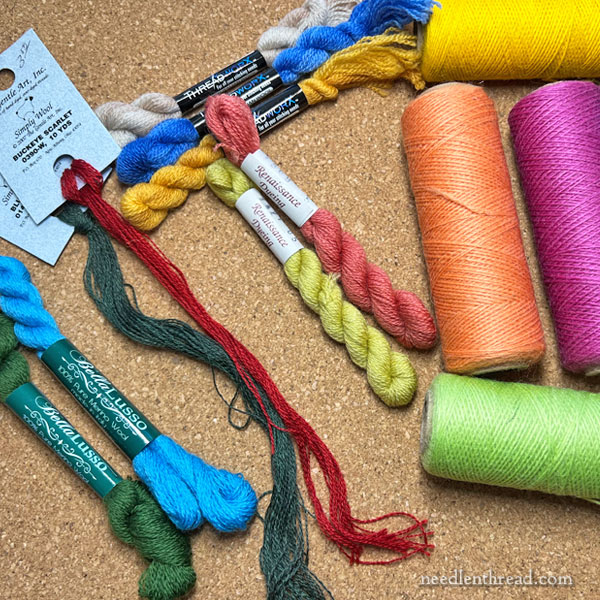
The first four types of crewel wool that we looked at in depth were Appletons, Fine d’Aubusson, Heathway, and DMC’s Eco Vita. These are the articles that explored these four threads specifically, if you haven’t read them yet:
- A Close Look at Crewel Embroidery Threads – where we talk in general about those four brands of crewel wool
- Wool Embroidery Threads Stitched – where we talk about the weight and different characteristics of those four wool threads when stitched in lines
- Wool Thread Comparisons: Fillings – where we explore those four wool threads in filling stitches
Now we’re going to move on to some other types of wool embroidery threads. Some of these brands are better known than others. I’ve had a lot of these threads in my stash for a while, so the packaging (and even branding) may have changed, but all of these threads are still available.
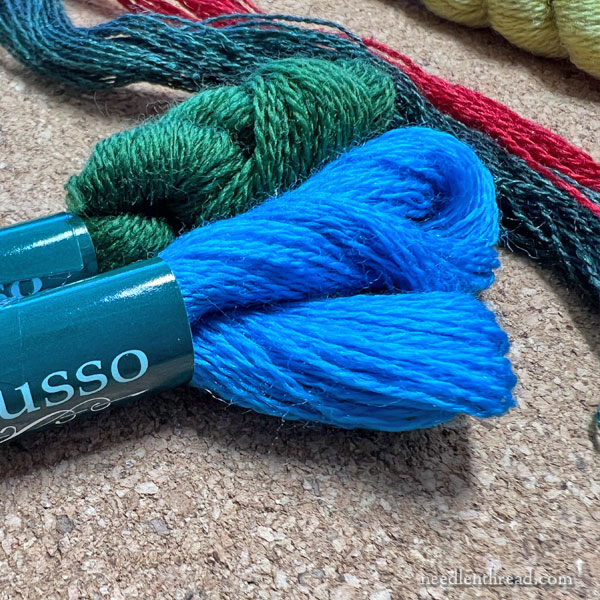
We’re going to look at Bella Lusso, which is a merino wool from Italy distributed by Fleur de Paris. It comes in a 45-yard twisted skein. It’s sold mostly as a needlepoint wool, for 13 – 18 hpi (holes per inch) canvas. I’ve also used Bella Lusso for surface embroidery, successfully.
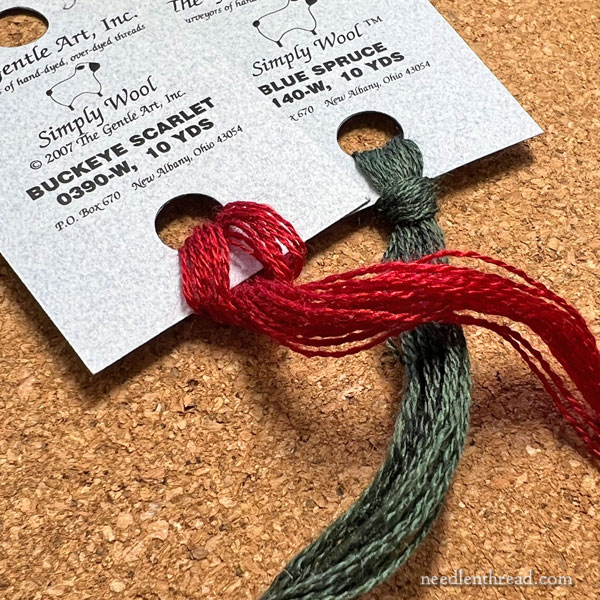
We’ll also look at Simply Wool threads from The Gentle Art. This is a hand dyed wool (it’s very subtle dying) for hand stitching. It’s quite a fine thread, and it comes 2-yard cuts in a 10-yard (total) bundle.
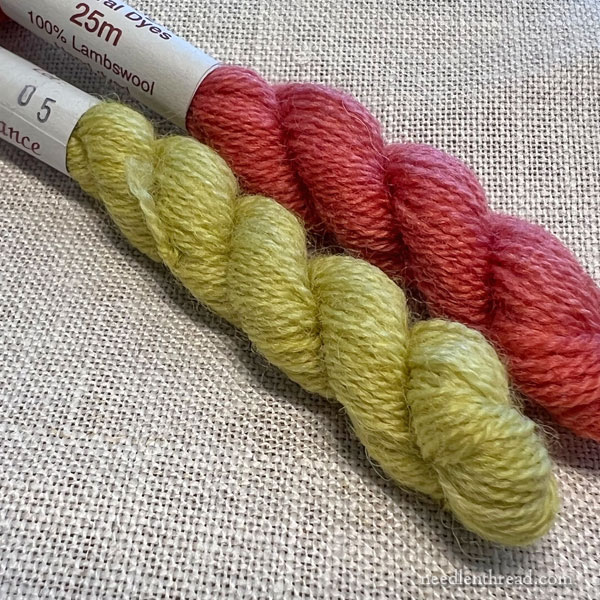
Another wool on the list is Renaissance Dyeing crewel wool, which is now produced by a mother-daughter team under the business name La Nollin. I haven’t tried this wool since the thread switched ownership, but I’m confident that it is the same or very similar to the original Renaissance Dyeing wool. This is 100% lambswool, naturally dyed, in 25 meter twisted skeins or in 250 meter twisted skeins. The thread is sold for embroidery, but I believe it is also used for knitting as an “ultra lace weight” thread.
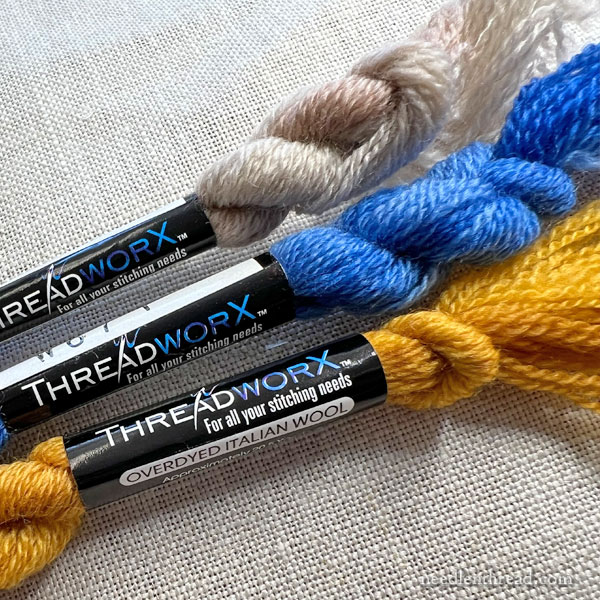
In this group, we’re also going to take a look at Threadworx wool threads. These are sold primarily for the needlepoint market, but I’ve used them for hand embroidery as well. They’re an overdyed Italian wool, in approximately a 20.5 yard twisted skein. This is the same wool as Bella Lusso, but it’s overdyed by the folks at Threadworx.
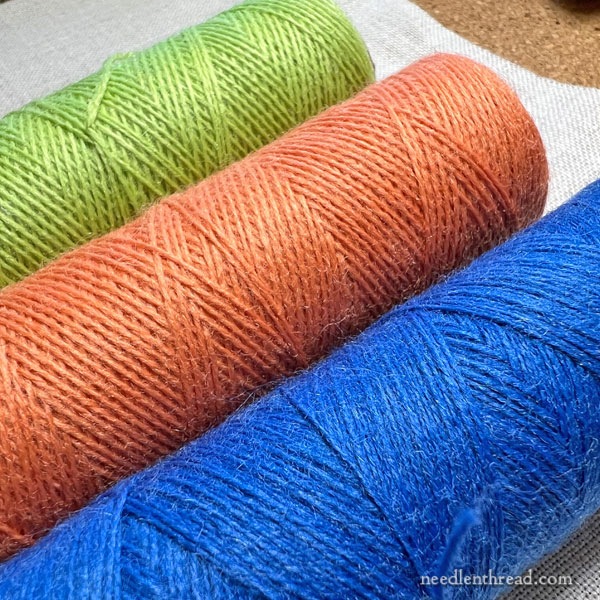
Finally, we’re going to look at Array Wool. I got this wool from Zollie, a company that uses the wool as their embroidery thread for cross stitch and other needlework kits. The thread is a very fine-weight (thin) worsted spun wool thread, 2-ply, made from Corriedale and Columbia sheep raised in the western US.
The thread is spun and dyed in North Carolina. Unlike most wool threads that are used for embroidery, this thread comes on cones (lots of thread on a cone – 210 yards!). It is sold predominantly for weaving (hence, the cones).
Next Explorations
So these are the threads we are going to explore next – not necessarily in the order given above, but I will make sure you know which thread is which as we test stitch with them and discuss their characteristics.
Some of the threads are great for surface embroidery. Some, we might find work better for other needlework purposes. We will discuss all that!
After we finish with this miscellaneous group of threads, we’re going to explore Gumnuts out of Australia. They produce wool threads and wool blends that deserve their own close look!
So that’s what’s coming up on the wool thread front!
On Monday, let’s talk about everyone’s favorite tools…. Scissors! The needlework market suffered a real loss when DOVO when out of business. They really made great embroidery scissors! And finding scissors that compare has been tough! But hey, guess what? There is a nice new pair of embroidery scissors out there that ticks all the boxes, so I’ll show those to you.
Have a fabulous weekend!







Mary: I love your material reviews; they are sooo helpful. I am hoping you will also consider doing DMC’s new line of wool threads – Eco Vita, a line of natural dyed organic wools.
Hi, Jan, I have reviewed those and written up a very thorough comparison with other common wools. That’s what started this whole series on wool threads. If you go back to the previous articles that are linked to in this article, you’ll find plenty of information on them, especially compared to other wool threads.
Thank you for EVERYTHING about wool threads! I wonder what the best way is to store wool pieces and wool threads in. Do you need to put cedar bars with them? Thank you again.
Well, if you’re in an area that’s prone to bugs or high humidity, you’ll want to take extra care in storing your wool-embroidered goods. Don’t store them in anything airtight – they need air. So ziplocks and the like are out of the question! I’d probably wrap in tissue paper (pH neutral is probably a good idea) or even put in an acid-free storage boz. I’m not sure I’d use cedar bars in with the fabric where it is touching the fabric – I’d probably include them in the drawer or closet through where I’d keep the box.
Thank you Mary; I can’t wait to hear all about wool threads. 🙂
I didn’t see reference to Waverly wool which is made in Mitchell, Nebraska. I used to use Paternayan wool but it is no longer available. I have used Waverly, in canvas embroidery and needlepoint church kneeler cushions which are stitched with a variety of canvas stitches meant to cover the canvas. It is a little thick for 18 count canvas but I would think you might be familiar with it. Brown Sheep Company manufactures it. Perhaps you limited your discussion to wool embroidery on fabric.
Hi, Lois – thanks for your note! We’re kind of looking more at threads that care used for hand embroidery, more than for needlepoint. Paternayan and Waverly are both tapestry wool used on canvas, which behaves somewhat differently from wool that passes in and out of fabric. Even so, we will be talking about some wools that are more tapestry weight. I can’t really afford to invest in every single type of thread that’s available out there, so I’m pretty much only focusing on the ones that I’ve used, that I’m familiar with, that I have at ;east a small supply of, without having to order in a bunch of thread. If I come across some threads that I’m curious about that are definitely geared towards surface embroidery, crewel work, and similar, then I may reach out the manufacturer or invest in a couple skeins to try them out. It really just depends!